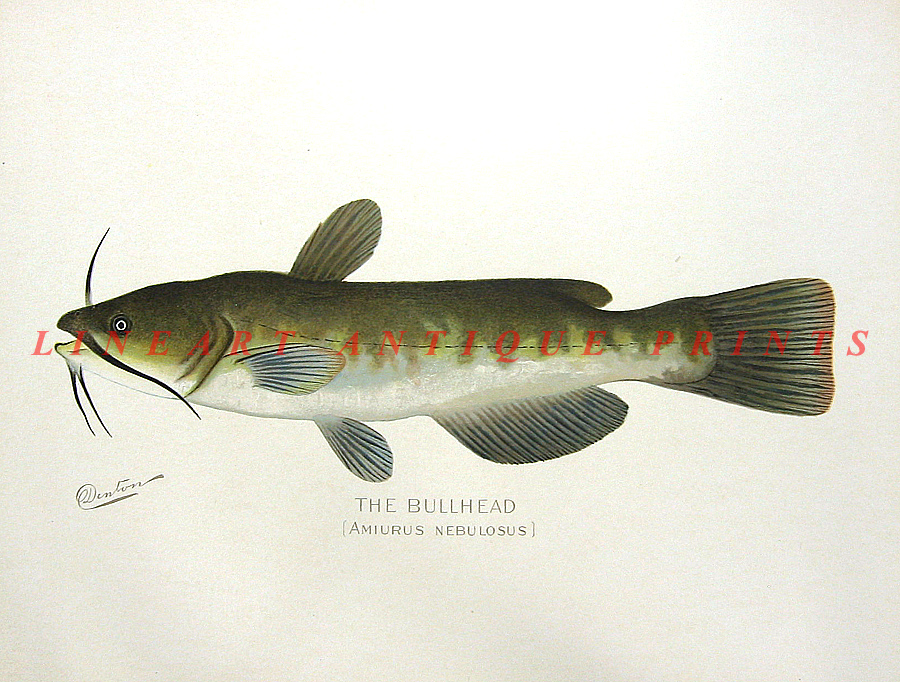THE BULLHEAD (Amiurus Nebulosus) Artist: Sherman Denton |

NOTE: THE RED LETTERING ON THE PRINT IS A WATERMARK I ADDED DIGITALLY AND IS NOT ON THE ACTUAL PRINT!
CLICK HERE TO SEE MORE 19th CENTURY FISH & GAME COLOR PRINTS!!
PRINT SIZE: Overall print size is 8 x 11 inches.
We pack properly to protect your item!
PRINT DESCRIPTION :
The brown bullhead, Ameiurus nebulosus, is a fish of the Ictaluridae family that is widely distributed in North America. It is a species of bullhead catfish and is similar to the black bullhead (Ameiurus melas) and yellow bullhead (Ameiurus natalis). It was originally described as Pimelodus nebulosus by Charles Alexandre Lesueur in 1819, and is also referred to as Ictalurus nebulosus. The brown bullhead is also widely known as the "mud pout", "horned pout" or "hornpout" or simply "mud cat", along with the other bullhead species. The brown bullhead is important as a clan symbol of the Ojibwe group of Native Americans. In their tradition, the bullhead or "wawaazisii" is one of six beings that came out of the sea to form the original clans. The brown bullhead thrives in a variety of habitats, including lakes and ponds with low oxygen and/or muddy conditions. In many areas of the U.S., Brown Bullheads are opportunistic bottom feeders. They eat insects, leeches, snails, fish, clams, and many plants. They are also known to eat corn, which can be used as bait. Similar to other catfish, they spawn only after the temperature of the water has reached 80 degrees Fahrenheit (27 °C) (cooler in the northern US) in June and July.%0d%0aWhen caught in very clear water when the flesh is firm and reddish to pinkish, the hornpout is quite edible and delicious. Nevertheless, its genial cousins such as the channel catfish and the blue catfish are better known for their consumption qualities. Hornpout are not commonly eaten nor are they sought by anglers and usually caught while pursuing other fishes. In most areas, they will not exceed two pounds in weight, with a current IGFA world's record of 6 lb 5oz , by Ray Lawrence, Lake Mahopac NY, Sept. 2002. Minnesota lists a 7 lb 1 oz brown bullhead, but it was never officially recognized.
%0d%0a Sherman Foote Denton (1856-1937) was born in Wellesley, Massachusetts , S.F. Denton was a multi-talented artist, scientist and skilled entrepreneur in business. His interest in natural history encompassed not only fish, but butterflies and moths, insects, birds, fossils, freshwater pearls and gems. During the 1880s, he and his brothers went on trips to the Western U.S. and accompanied their father, a geologist, on an expedition to Australia, New Zealand and New Guinea, where collected natural history specimens. Returning to the U.S., Denton worked as an artist for the United States Fish Commission at the Smithsonian Institute between 1896 and 1890, where he illustrated their reports with chromolithograph prints and also developed and patented a method for mounting fish without losing the natural colors. He became the leading maker of fish models for collectors and museums such as the Smithsonian, the Field Museum in Chicago and the Agassiz Museum at Harvard. He also invented a method for mounting butterflies, and amassed the most important collection of freshwater pearls in the U.S. Sherman, along with his brothers William, Winsford and Shelley (a noted naturalist in his time) became famous at the 1900 Paris Exposition for their award-winning moth and butterfly collections. Sherman Denton was also renowned among the leading naturalists of his day for developing and patenting methods to preserve fish, butterflies and moths in a much more life-like state.